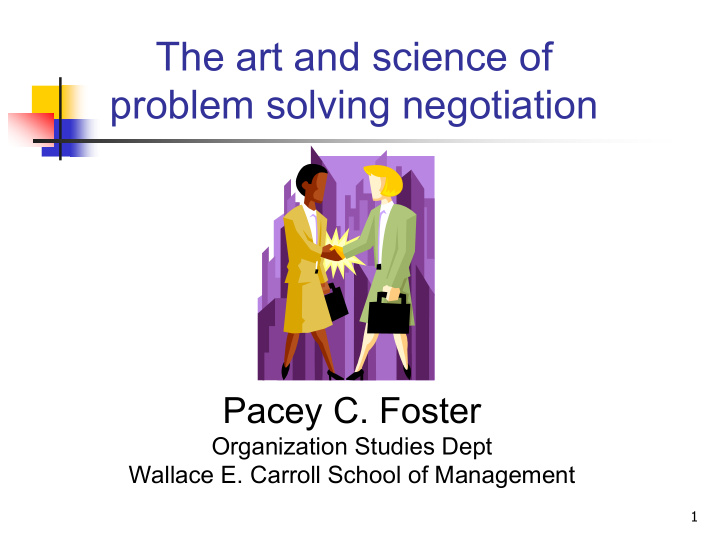



The art and science of problem solving negotiation Pacey C. Foster Organization Studies Dept Wallace E. Carroll School of Management 1
Arm Exercise • Pair up with some • Get in position as if you were going to arm wrestle with each other • Score a point every time the back of the others hand touches the desk • Objective: Get as many points as possible • You have 30 seconds to do this 2
Roadmap for the hour • Deepen our understanding of conflict dynamics in groups • Identify two dominant models of negotiation • Explore the limits of these models • Provide a more effective and efficient alternative model 3
The chocolate conundrum Rules: • No talking • You want to maximize return for you personally (the others work for another firm) • You can grab all you can get at the beginning of each round • If any are left at the end of a round they will double, but: • The bowl can’t hold more than the initial amount • No punching, eye gouging, etc. 4
Prisoner’s Dilemma Game Their choice Cooperate Compete Cooperate You achieve You loose Your choice good gains big, they win and so do big they Compete You win big, You both they loose loose, but big not as much as if one had cooperated 5
Negotiation Defined An interaction between two or more interdependent parties designed to achieve each party’s goals through processes of mutual influence 6
Two Negotiation Paradigms Hard Bargainer: •Your loss is my gain (zero-sum) •Objective is to win •Start high and concede grudgingly •Don’t volunteer information Soft Bargainer: •Both sides can always win (find joint gains) •Objective is to maintain the relationship at all costs 7 •Be honest and share information
Which approach is best? The soft bargainer says: “The world can be a win-win garden.” The hard bargainer says: “The world is a zero-sum jungle.” 8
Answer: Neither! Effective negotiators manage the tension between…. CREATING VALUE and CLAIMING VALUE 9
The negotiator’s dilemma Fighting for a big piece of a small pie (claiming value) Working to make the pie bigger (creating value) Spring 1991 10
Managing the negotiator’s dilemma Seek more efficient solutions Pareto (Efficient) Frontier High Value To X Low Low High Value To Y 11
Managing the negotiator’s dilemma Use problem solving negotiation –BATNA (best alternative to a negotiated agreement) –Separate People from Problem –Interests, not Positions –Brainstorm Options for Mutual Gain –Invoke Objective Criteria –Commit Wisely 12
Problem solving negotiation process 1. Understand context 2. Develop relationship and test assumptions Create 3. Establish process value 4. Explore interests and issues 5. Brainstorm options and consider Claim packaging value 6. Determine legitimate criteria 7. Evaluate options 8. Plan implementation 9. Secure agreement 13
Summary • Negotiation is a process of mutual influence among interdependent parties • Don’t think in terms of hard/soft • Manage the negotiator’s dilemma effectively • Use a problem solving approach 14
Recommend
More recommend